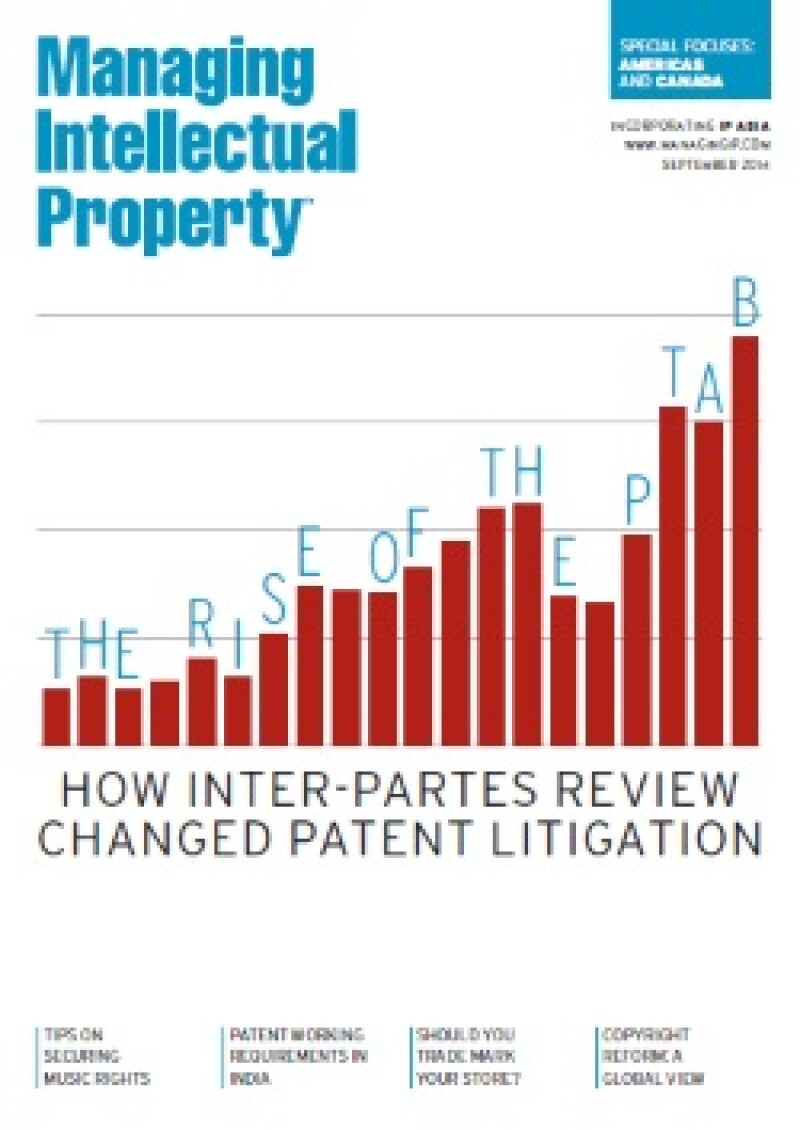
The cover story of Managing IP’s September issue, which has just been published online, assesses the state of play for the PTAB almost two years after the new inter partes review and covered business method proceedings became available on September 16 2012.
The special report is in three parts available to subscribers and trialliists: part one looks at the surprising popularity of the PTAB and how the Federal Circuit will react; part two looks at why PTAB proceedings are catching on among pharma companies; and part three looks at the lessons learned from proceedings so far.
After a cautious beginning, petitions at the PTAB have gone through the roof since the middle of last year. As the report reveals, the popularity of these proceedings has left some patent owners worried that some of their best IP assets are at risk.
Going through PTAB proceedings is certainly harder and more daunting for patent owners than it is for petitioners. The very first IPR decision out of the PTAB, Garmin v Cuozzo, made it clear that there would be very little chance for discovery. A common gripe among patent owners is also that it is nigh on impossible to be granted a motion to amend. Live testimony, too, is rare, despite a general expectation that it would be permitted.
There has been only one instance of an amendment and only one instance of live testimony. The one amendment – granted, perhaps ironically, by the government to the government – has also been viewed more as a settlement than an amendment because it was unopposed.
As my story makes clear, many patent owners feel like the goalposts have been shifted on them. While some observers are pleased that there is now a relatively quick and efficient process for knocking out patents that should not have been granted – and thus providing an effective weapon against patent trolls whose potency has yet to be appreciated in the wider world – it is possible to also feel some sympathy for patent owners. Claims that were drafted for a different time and a different forum now suddenly look at risk, especially if there is no chance for amending them.
Concerned patent owners will be heartened to hear, then, that experienced USPTO watchers are sure that changes will be made to proceedings to take their concerns into account. The USPTO is canvassing the market for feedback on 17 suggested potential areas for change. Written comments must be received by September 16.
As former USPTO director David Kappos told me for the story: “I am 100% confident they will make some changes from what they learned from the input they are getting. I wouldn’t be surprised if some adjustments were made in the areas of permitting claim amendment and discovery.”
Changes at the PTAB may be afoot, then.
Below are my picks for 10 of the biggest PTAB milestones so far. What do you think will be some of the biggest ones to look out for going forward?
We will publish the second installment of our in-depth look into the PTAB online next month. This will include interviews with in-house counsel, statistics on the PTAB’s timeliness on hearings and determinations, and analysis of institutions and the most common reasons for denial.
If you like what you see, why not keep on top of our PTAB analysis with a subscription by contacting Baldeep Dohil on +44 (0) 207 779 8788 or email bdohil@managingip.com.
10 PTAB milestones |
September 16 2011: The America Invents Act signed into law, including the introduction of new post-grant procedures and the creation of the Patent and Trial Appeal Board September 16 2012: The first day the proceedings are available, the first petition for an IPR is filed June 12 2013: PTAB finds all five challenged claims invalid in its first CBM review trial SAP v Versata, with the Board confirming it will assume the “broadest reasonable interpretation” of a patent November 13 2013: PTAB issues first written decision under the inter partes review system, finding in favour of Garmin and invalidating Cuozzo’s patents covering LCD technology in Garmin v Cuozzo December 31 2013: The PTAB ends the year as the third most popular forum for patent litigation (with 792 cases filed, according to Fish & Richardson), behind the Eastern District of Texas (1,512) and the Delaware District (1,337) May 20 2014: PTAB grants a motion to amend claims in an inter partes review proceeding for the first time, in International Flavors and Fragrances v The United States of America. The government was allowed to substitute 19 new claims to replace the originally patented claims June 15 2014: The PTAB hears live testimony for the first time in an inter partes review, allowing patent owner Escort to quiz the inventor of a police radar detector covered by US patent 7,999,721 July 10 2014: The Federal Circuit reverses district court’s denial of stay pending outcome of a cared business method review in VirtualAgility v Salesforce July 31 2014: PTAB issues first decision designated as “precedential”, in covered business method review proceeding SecureBuy v CardinalCommerce August 5 2014: The first post-grant review petition is filed by LeRose Industries and Toys “R” Us against patent 8,684,420, owned by Choon’s Design, the company that makes the popular Rainbow Loom elastic bands |








